Multi process
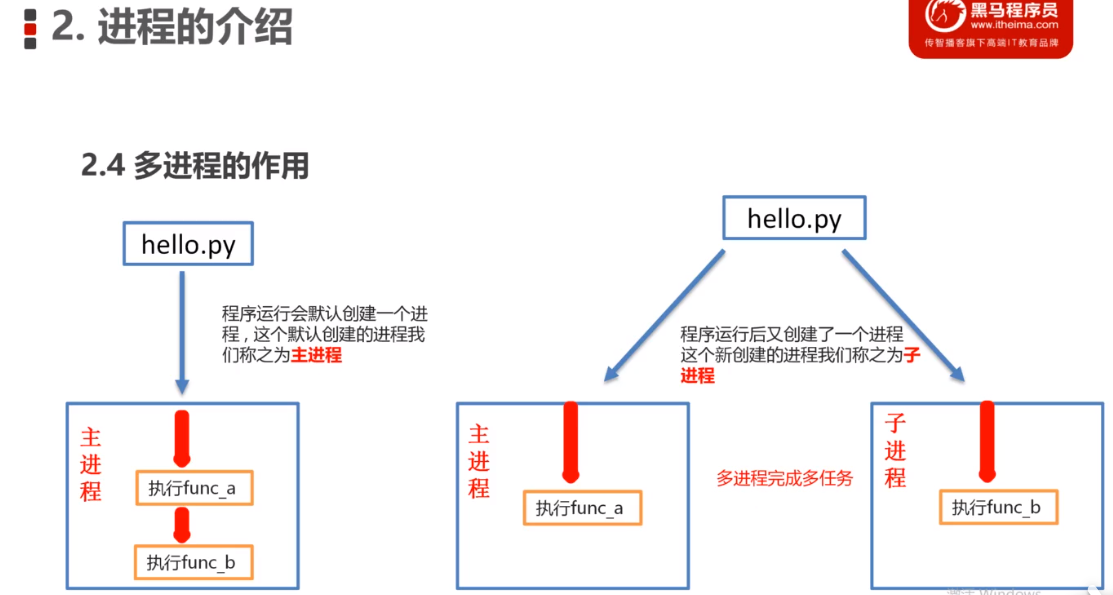
A running program is called a process
3. Multi process and multi task
3.1 process creation
# 1. Import process package import multiprocessing # 2. Create process objects through process classes Process object = multiprocessing.Process() # 3. Start the process and perform the task Process object.start()
3.2 creating process objects through process classes
Process object = multiprocessing Process (target = task name)
| Parameter name | explain |
|---|---|
| target | The name of the target task to be executed. Here, it refers to the name of the gain / loss function (method name) |
| name | Process name, generally not set |
| group | Process group. Currently, only None can be used |
3.3 process creation and startup code
# Create child process -- singing sing_process = multiprocessing.Process(target=sing) # Create child process -- dance dance_process = multiprocessing.Process(target=dance) # Start process sing_process.start() dance_process.start()
Single task py
import time
# sing
def sing():
for i in range(3)
print("sing...")
time.sleep(0.5)
# dance
def dance()
for i in range(3)
print("dance...")
time.sleep(0.5)
if __name__ = '__main__':
sing()
dance()
Multitasking using multiple processes py
# 1. Import process package
import multiprocessing
import time
# sing
def sing():
for i in range(3)
print("sing...")
time.sleep(0.5)
# dance
def dance()
for i in range(3)
print("dance...")
time.sleep(0.5)
if __name__ = '__main__':
# 2. Create process object using process class
# target: Specifies the name of the function executed by the process
sing_process = multiprocessing.Process(target = sing)
dance_process = multiprocessing.Process(target = dance)
# 3. Use the process object to start the process and execute the specified task
sing_process.start()
dance_process.start()
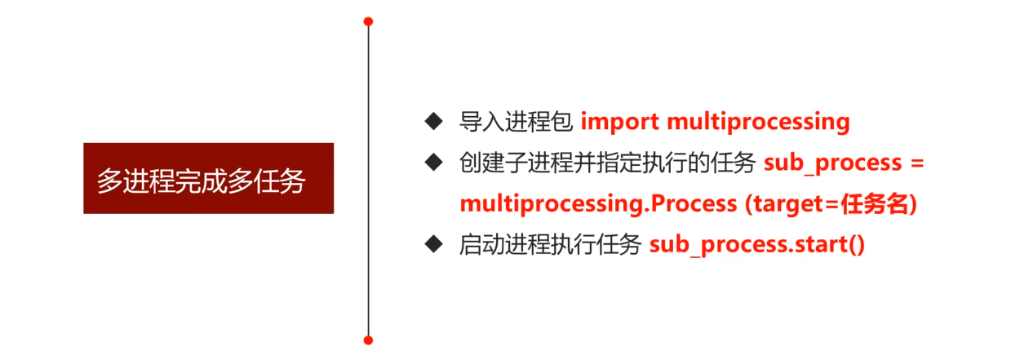
4. The process executes tasks with parameters
4.1 the process executes tasks with parameters
| Parameter name | explain |
|---|---|
| args | Pass parameters to the executed task in the way of Yuanzu |
| kwargs | Pass parameters to the executed task in the form of dictionary |
4.2 use of args parameter
# target: the name of the function executed by the process # args: it means to pass parameters to the function in the way of Yuanzu sing_process = multiprocessing.Process(target = sing, args=(3,)) sing_process.start()
4.3 use of kwargs parameters
# target: the name of the function executed by the process
# kwargs: means to pass parameters to a function in the form of a dictionary
dance_process = multiprocessing.Process(target = dance, kwargs={"num":3})
dance_process.start()
The process executes a task with parameters py
# 1. Import process package
import multiprocessing
import time
# sing
def sing(num):
for i in range(num)
print("sing...")
time.sleep(0.5)
# dance
def dance(num)
for i in range(num)
print("dance...")
time.sleep(0.5)
if __name__ = '__main__':
# 2. Create process object using process class
# target: Specifies the name of the function executed by the process
# args: use ancestor method to pass parameters to the specified task
# kwargs: pass parameters to functions using dictionaries
sing_process = multiprocessing.Process(target = sing, args=(3,))
dance_process = multiprocessing.Process(target = dance, kwargs={'num':2})
# 3. Use the process object to start the process and execute the specified task
sing_process.start()
dance_process.start()
When using Yuanzu parameters, the order of parameters must be consistent
When using dictionary to transfer parameters, you must ensure that the key and parameter name are consistent
5. Get process number
Role of process number:
When there are more and more processes in the program, if there is no way to distinguish the main process from the sub process, and there are different sub processes, then effective process management cannot be carried out. In order to facilitate management, in fact, each process has its own number
Two ways to get the process number
1. Get the current process number
os.getpid()
2. Get the current parent process number
os.getppid()
5.1 os. Use of getpid()
import os pid = os.getpid() print(pid)
5.2 os. Use of getppid()
def work():
# Gets the number of the current process
print("work Process number:", os.getpid())
# Gets the number of the parent process
print("work Parent process number:", os.getppid())
The process executes a task with parameters py
# 1. Import process package
import multiprocessing
import time
import os
# sing
def sing(num,name):
print("Singing process pid: ",os.getpid())
print("Parent process of the process pid: ",os.getppid())
for i in range(num)
print(name)
print("sing...")
time.sleep(0.5)
# dance
def dance(num,name)
print("Dance progress pid: ",os.getpid())
print("Parent process of dance process pid: ",os.getppid())
for i in range(num)
print(name)
print("dance...")
time.sleep(0.5)
if __name__ = '__main__':
print("Of the main process pid: ",os.pid())
# 1. Main process, create sub process object and specify the task name to be executed
sing_process = multiprocessing.Process(target = sing, args=(3,"Xiao Ming"))
dance_process = multiprocessing.Process(target = dance, kwargs={'num':2,'name':"Xiao Hong"})
# 2. Start the subprocess and execute the task
sing_process.start()
dance_process.start()
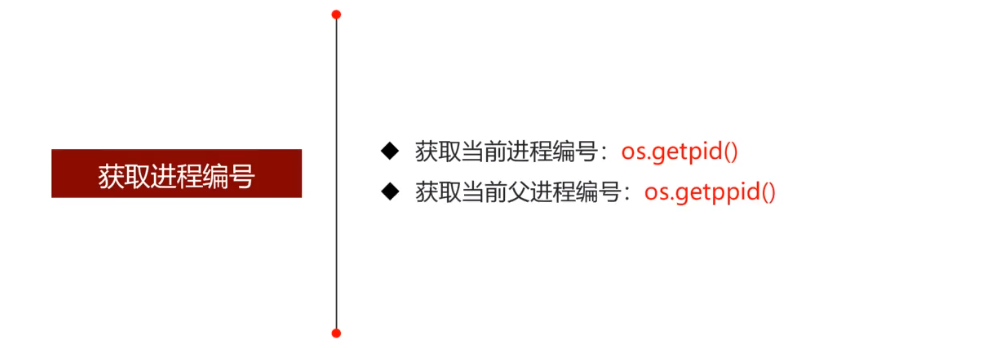
6. Process considerations
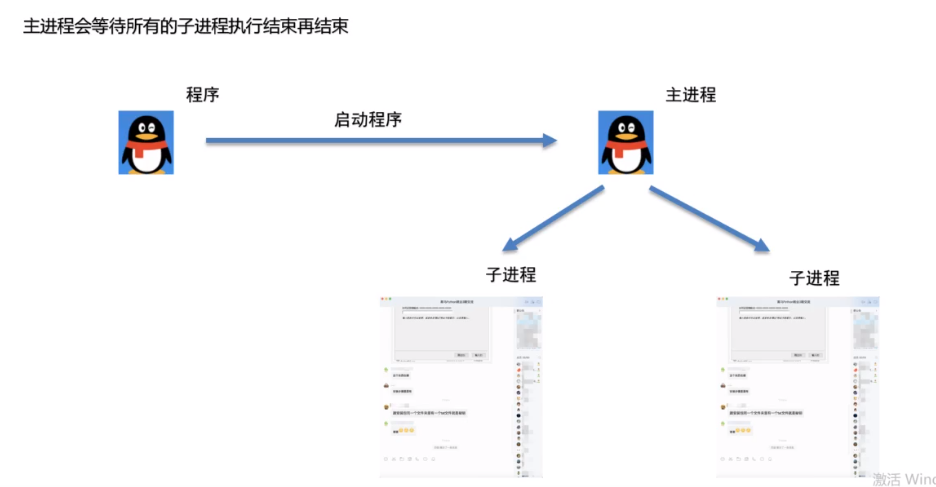
6.1 the main process will wait until the execution of all sub processes is completed
import multiprocessing
import time
def work()
for i in range(10):
print("at work...")
time.sleep(0.2)
if __name__ = '__main__':
# Create child process
work_process = multiprocessing.Process(target=work)
work_process.start()
# Let the main process wait for 1s
time.sleep(1)
print("The execution of the main process is complete!")
6.2 setting the main daemon
import multiprocessing
import time
def work()
for i in range(10):
print("at work...")
time.sleep(0.2)
if __name__ = '__main__':
# Create child process
work_process = multiprocessing.Process(target=work)
# Set the main process to be guarded. After the main process exits, the child process will be destroyed directly and the code of the child process will no longer be executed
work_process.deamon = True
work_process.start()
# Let the main process wait for 1s
time.sleep(1)
print("The execution of the main process is complete!")
6.3 key points of knowledge
In order to ensure the normal operation of the child process, the main process will wait for all child processes to be destroyed after execution. The purpose of setting the guardian main process is that the main process exits and the child process is destroyed, so that the main process will not wait for the child process to execute.
Set the mode of main daemon: child process object daemon = True
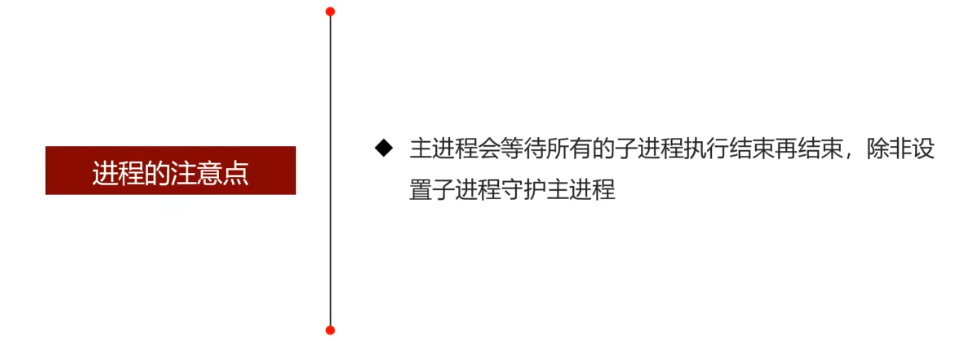
7. Case - high concurrency copy device of intelligence teaching video folder (multi process)
requirement analysis
- Whether the target folder exists. If it does not exist, it will be created. If it does not exist, it will not be created
- Traverse all files in the source folder and copy to the destination folder
- Multi task is realized by process to complete high concurrent copy
Implementation steps
1. Define the path where the source folder is located and the path where the destination folder is located
# 1. Define the source file directory and the destination folder directory source_ dir = "python Teaching video" dest_ dir = "/home/python/desktop/test"
2. Create destination folder
try:
# 2. Create destination folder directory
os.mkdir(dest_dir)
except:
print("The destination folder already exists, Not created~")
3. Via OS Listdir gets the list of files in the source directory
# 3. List all the files in the original file file_list = os.listdir(source_dir) print(file_list)
4. Traverse each file and define a function to copy the file
# 4. The for loop copies each file in turn
for file_name in file_list:
copy_work(file_name,source_dir,dest_dir)
5. Multi task is realized by process to complete high concurrent copy
for file_name in file_list:
sub_process = multiprocessing.Process(target=copy_work,args=(file_name,source_dir,dest_dir))
sub_process.start()
Implementation steps of document price copy function
def copy_work(file_name,source_dir,dest_dir)
# 1. The path where the source and destination files are spliced
source_path = source_dir+"/"+file_name
dest_path = dest_dir+"/"+file_name
print(source_path,'------>',dest_path)
# 2. Open the source file and create the directory file
with open(source_path,"rb") as source_file:
with open(dest_path,"wb") as dest_file:
# 3. Read the contents of the source file and write to the target file (loop)
while True:
# Loop read data
file_data = source_file.read(1024)
if file_data:
# Write loop to target file
dest_file.write(file_data)
else:
break
Multi - process to realize the copy of intelligence teaching video py
import multiprocessing
import os
def copy_work(file_name,source_dir,dest_dir)
# 1. The path where the source and destination files are spliced
source_path = source_dir+"/"+file_name
dest_path = dest_dir+"/"+file_name
print(source_path,'------>',dest_path)
# 2. Open the source file and create the directory file
with open(source_path,"rb") as source_file:
with open(dest_path,"wb") as dest_file:
# 3. Read the contents of the source file and write to the target file (loop)
while True:
# Loop read data
file_data = source_file.read(1024) # 1024 bytes read at a time
if file_data:
# Write loop to target file
dest_file.write(file_data)
else:
break
if __name__ == '__main__'
# 1. Define source folder and destination folder
source_dir = "./python Teaching video"
dest_dir = "./test"
# 2. Create target folder
try:
os.mkdir(dest_dir)
except:
print("The destination folder already exists, Not created~")
# 3. Read the file list of the source folder
file_list = os.listdir(source_dir)
# 4. Traverse the file list to copy
for file_name in file_list:
# copy_work(file_name,source_dir,dest_dir)
# 5. Use process to realize multi task and complete high concurrent copy
sub_process = multiprocessing.Process(target=copy_work,args=(file_name,source_dir,dest_dir))
sub_process.start()

Multithreading
The process is the smallest unit to allocate resources. Once a process is created, certain resources will be allocated, just as it is necessary to open two QQ software to chat with two people about QQ. It is a waste of resources.
Thread is the smallest unit of program execution. In fact, a process is only responsible for allocating resources, and threads use these resources to execute programs, that is, a process is a container of threads. At least one thread in a process is responsible for executing programs At the same time, the thread itself does not have system resources and only needs a little essential resources in operation, but it can share all the resources owned by the process with other threads belonging to the same process. This is like opening two windows (two threads) to chat with two people through a QQ software (one process), which not only realizes multitasking, but also saves resources.
1 Introduction to multithreading
1.3 role of multithreading
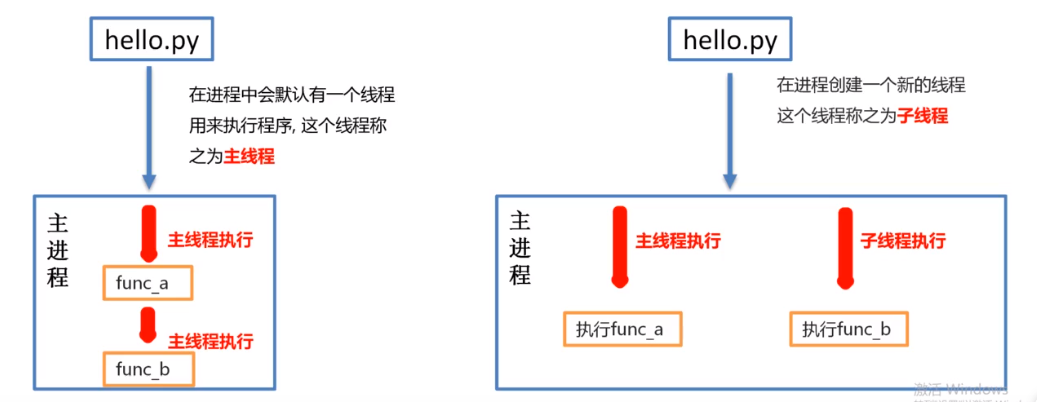
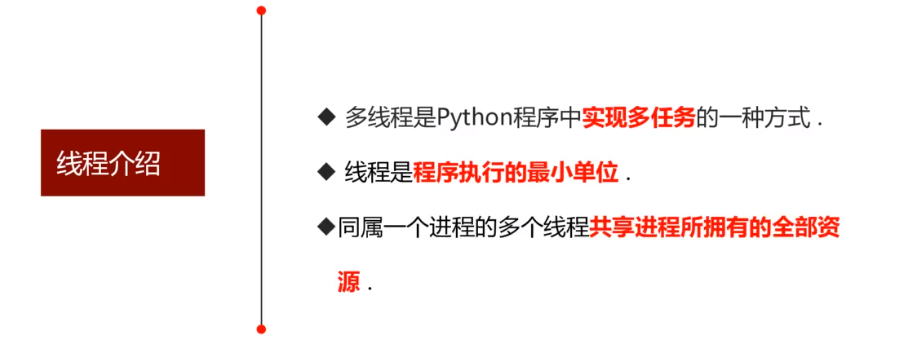

2 multithreading to complete multitasking
2.1 thread creation steps
1. Import thread module
import threading
2. Create thread objects through thread classes
Thread object = threading Thread (target = task name)
3. Start the thread to execute the task
Thread object start()
2.2 creating thread objects through thread classes
Thread object = threading Thread (target = task name)
| Parameter name | explain |
|---|---|
| target | The name of the target task to be executed, which refers to the function name (method name) |
| name | Thread name, - generally not set |
| group | Thread group. Currently, only None can be used |
2.3 code for thread creation and startup
import threading # Create child thread sing_thread = threading.Thread(target=sing) # Create child thread dance_thread = threading.Thread(target=dance) # Start thread sing_thread.start() dance_thread.start()
Multitasking with multithreading
# 1. Import thread module
# 2. Create thread object
# 3. Start the thread and execute the task
import time
import threading
def sing():
for i in range(3):
print("sing...")
time.sleep(1)
def dance():
for i in range(3):
print("dance")
time.sleep(1)
if __name__ == '__main__':
# sing()
# dance()
sing_thread = threading.Thread(target=sing)
dance_thread = threading.Thread(target=dance)
sing_thread.start()
dance_thread.start()

3 threads execute tasks with parameters
3.1 threads execute tasks with parameters
| Parameter name | explain |
|---|---|
| args | Pass parameters to the executed task in the way of Yuanzu |
| kwargs | Pass parameters to the executed task in the form of dictionary |
3.2 use of args parameter
# target: the name of the function executed by the process # args: it means to pass parameters to the function in the way of Yuanzu sing_thread = threading.Thread(target = sing, args=(3,)) sing_thread.start()
3.3 use of kwargs parameters
# target: the name of the function executed by the process
# args: it means to pass parameters to the function in the way of Yuanzu
sing_thread = threading.Thread(target = sing, kwargs={"count":3})
sing_thread.start()

4 end order of main thread and sub thread
import time
import threading
def work():
for i in range(10):
print("work...")
time.sleep(0.2)
if __name__ == '__main__':
sub_thread = threading.Thread(target=work)
sub_thread.start()
# The main thread is delayed by 1 second
time.sleep(1)
print("over")
4.1 setting the main daemon thread
# To guard the main thread mode 1 Daemon = true daemon main thread
work_thread = threading.Thread(target=work,daemon=True)
# Set main thread guard mode 2
# work_thread.setDaemon(True)
work_thread.start()
# The main thread is delayed by 1 second
time.sleep(1)
print("over")

5 execution order between threads
Inter thread execution order

5.1 execution between threads is out of order
for i in range(5):
sub_thread = threading.Thread(target=task)
sub_thread.start()
5.2 get the current thread information
# Through current_ The thread method gets the thread object current_thread = threading.current_thread() # Through current_ The thread object can know the relevant information of the thread, such as the order in which it is created print(current_thread)
Execution order between threads
import threading
import time
def task():
time.sleep(1)
# current_thread: get the thread object of the current thread
thread = threading.current_thread()
print(thread)
if __name__ = '__main__':
for i in range(5):
sub_thread = threading.Thread(target=task)
sub_thread.start()
# Conclusion: the execution between multithreads is disordered and scheduled by CPU

6 process and thread comparison
6.1 relationship comparison
- Threads are attached to processes. Without processes, there will be no threads.
- A process provides one thread by default, and a process can create multiple threads.
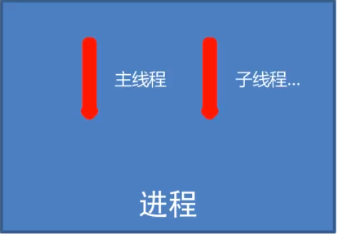
6.2 difference and comparison
- The resource cost of creating a process is greater than that of creating a thread
- Process is the basic unit of operating system resource allocation, and thread is the basic unit of CPU scheduling
- Threads cannot execute independently and must exist in the process
6.3 comparison of advantages and disadvantages
-
Process advantages and disadvantages
Advantages: multiple cores can be used
Disadvantages: high resource overhead
-
Thread advantages and disadvantages
Advantages: low resource overhead
Disadvantages: multi core cannot be used
Case 7 - high concurrency copy device for educational video folder (multithreading)
import threading
import os
def copy_work(file_name,source_dir,dest_dir)
# 1. The path where the source and destination files are spliced
source_path = source_dir+"/"+file_name
dest_path = dest_dir+"/"+file_name
print(source_path,'------>',dest_path)
# 2. Open the source file and create the directory file
with open(source_path,"rb") as source_file:
with open(dest_path,"wb") as dest_file:
# 3. Read the contents of the source file and write to the target file (loop)
while True:
# Loop read data
file_data = source_file.read(1024) # 1024 bytes read at a time
if file_data:
# Write loop to target file
dest_file.write(file_data)
else:
break
if __name__ == '__main__'
# 1. Define source folder and destination folder
source_dir = "./python Teaching video"
dest_dir = "./test"
# 2. Create target folder
try:
os.mkdir(dest_dir)
except:
print("The destination folder already exists, Not created~")
# 3. Read the file list of the source folder
file_list = os.listdir(source_dir)
# 4. Traverse the file list to copy
for file_name in file_list:
# copy_work(file_name,source_dir,dest_dir)
# 5. Use process to realize multi task and complete high concurrent copy
sub_thread = threading.Thread(target=copy_work,args=(file_name,source_dir,dest_dir))
sub_thread.start()
